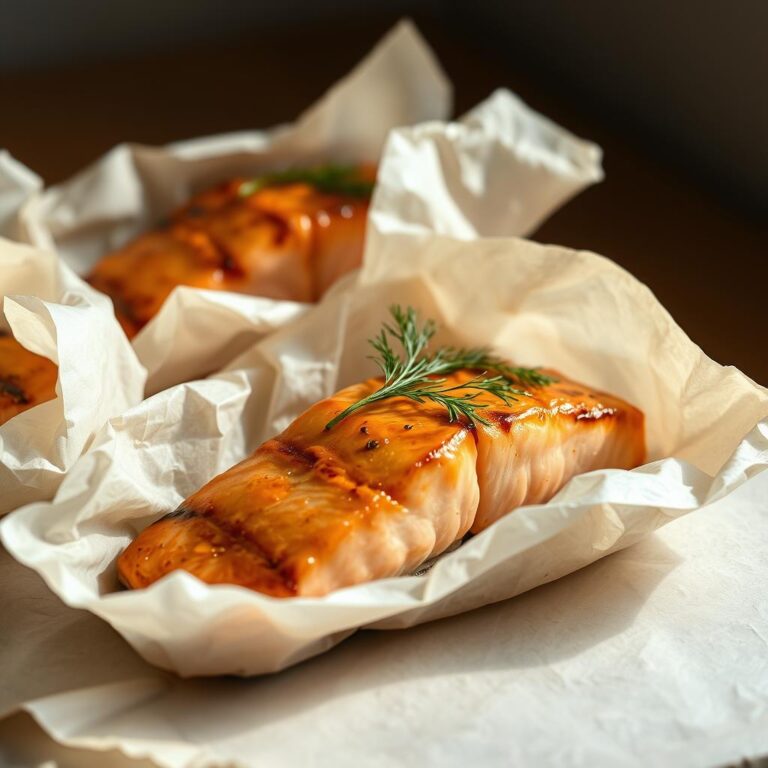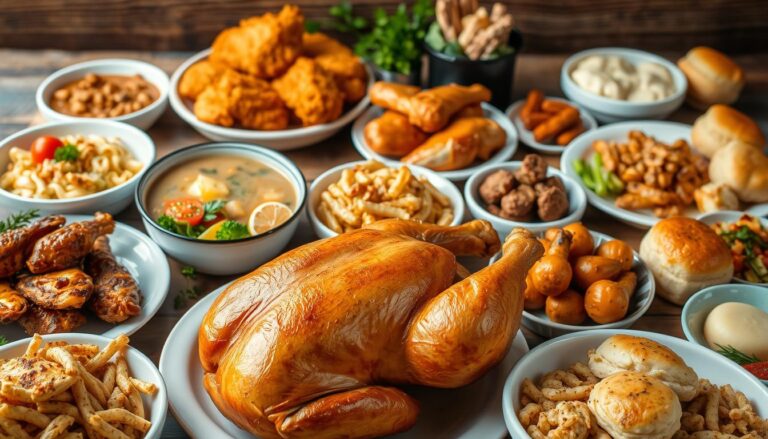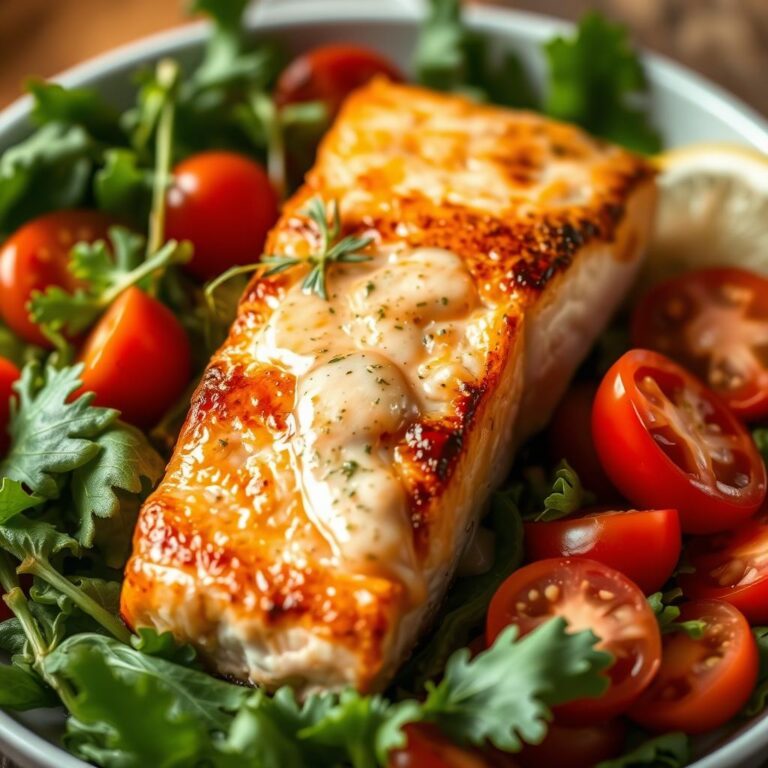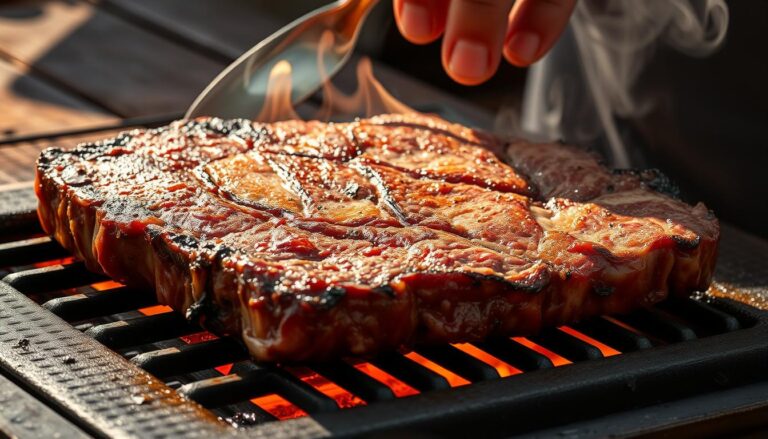Tender Beef Steak Recipes: How to Achieve the Perfect Steak Every Time
Every home cook dreams of making beef steak recipes as good as those in restaurants. The journey to mastering the perfect steak is about passion, precision, and understanding cooking.
Imagine cutting into a steak so tender it barely needs a knife. It has a golden-brown crust that keeps in rich, deep flavors. This isn’t just a dream—it’s a skill you can learn. Whether you’re new to cooking or have been doing it for years, you can make the perfect steak.
In this guide, we’ll share secrets for making delicious beef steak recipes. You’ll learn how to pick the right cut and control cooking temperatures. You’ll get all the tips you need to make a steak that’s as good as any steakhouse.
Key Takeaways
- Learn professional techniques for cooking tender steaks
- Understand the importance of meat selection and quality
- Master temperature control for consistent results
- Discover secrets to achieving restaurant-quality steaks at home
- Build confidence in your cooking skills
Essential Guide to Choosing the Perfect Cut of Steak
Choosing the right steak is key to a great meal. The meat you pick can make your meal unforgettable. Marbling and meat quality are important for flavor and tenderness.
Understanding Marbling and Meat Quality
Marbling is the white fat in meat. High-quality steaks have lots of marbling. This fat melts when cooked, adding flavor and juiciness.
Look for even fat distribution and a bright red color when checking meat quality. This means the steak is of high quality.
- Prime grade: Highest marbling, most tender
- Choice grade: Good marbling, excellent flavor
- Select grade: Leaner, less marbling
Best Cuts for Pan-Searing: Ribeye and NY Strip
For pan-searing, choose steaks that are one to one-and-a-half inches thick. Ribeye and New York Strip are top picks. They have great marbling and beef flavor.
Premium vs Budget-Friendly Steak Options
You don’t have to spend a lot for great steak. While tenderloin is very tender, sirloin and flat iron steaks are affordable and delicious with the right cooking.
- Premium cuts: Tenderloin, Ribeye
- Budget-friendly cuts: Sirloin, Flat Iron, Chuck Eye
For a fantastic steak, know about meat quality, pick the right cut, and cook it well.
Ultimate Guide for Beginners on Cooking Beef Steaks
Steak cooking basics might seem tough at first, but it’s easy once you know the basics. You’ll learn how to cook a tasty beef steak in no time. It all starts with a few key techniques that will boost your kitchen skills.
Here are the main steps to cook the perfect steak:
- Select a quality cut of beef
- Prepare your cooking surface
- Season appropriately
- Control cooking temperature
- Rest the meat after cooking
For beginners, picking the right cooking method is key. Different methods can greatly change how your steak turns out. Here are the main cooking ways:
| Cooking Method | Best For | Skill Level |
|---|---|---|
| Pan-Searing | Tender cuts like ribeye | Beginner |
| Grilling | Thicker steaks | Intermediate |
| Reverse Sear | Thick, high-quality cuts | Advanced |
Pro tip for steak cooking basics: Always let your steak come to room temperature before cooking. This helps it cook evenly and prevents it from being tough. With practice, you’ll get better at cooking steaks.
Remember, patience and paying close attention are important. Every steak is different, and learning to understand its unique qualities will make you a better cook.
Proper Steak Preparation Techniques
Steak preparation is an art that starts long before cooking. Knowing the right techniques can turn an ordinary cut into a top-notch meal. How you handle the meat affects its taste, texture, and cooking success.
To get the perfect steak, start with the right thawing methods. These methods keep the meat quality high and ensure even cooking. Proper preparation includes several key steps that can make your meal better.
Thawing Methods and Temperature Control
Safe thawing is key to keeping meat quality high. Here are some good ways to thaw:
- Refrigerator thawing: Move frozen steak to the fridge 24 hours before cooking
- Cold water method: Put sealed steak in cold water, change water every 30 minutes
- Avoid thawing at room temperature to stop bacterial growth
Surface Preparation and Drying
Getting the steak’s surface ready is important for a perfect sear. Dry the steak with paper towels to remove extra moisture. Moisture stops the beautiful browning that makes a tasty crust.
Room Temperature Guidelines
Let your steak sit at room temperature for 30-60 minutes before cooking. This makes cooking more even and helps the meat cook better. Try to keep the temperature around 60-65°F for more consistent cooking.
- Remove steak from fridge 30-60 minutes before cooking
- Keep steak covered to prevent contamination
- Don’t leave at room temperature for more than 2 hours
The Science of Seasoning Your Steak
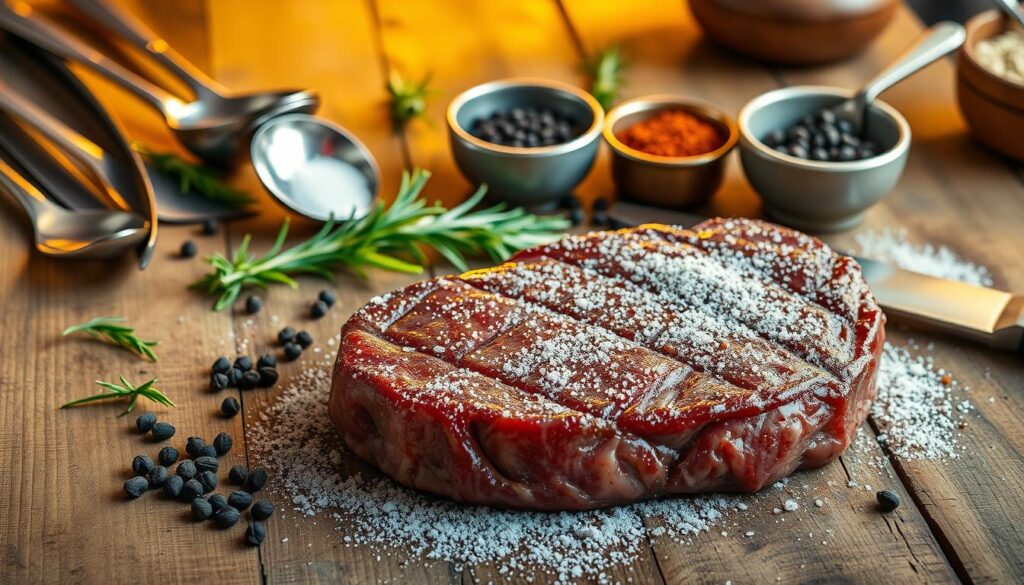
Mastering steak seasoning is an art that turns an ordinary cut into a culinary masterpiece. Salt for steak does more than add flavor. It enhances the meat’s natural taste and creates a perfect crust.
Seasoning steak is more than just shaking salt on it. The right approach can greatly improve its texture and taste. Professional chefs suggest specific techniques to boost flavor:
- Use kosher salt for even coverage
- Season generously before cooking
- Allow salt to penetrate the meat’s surface
- Pat the steak dry before seasoning
Different salts change your steak’s flavor in unique ways. Here’s a quick look at salt varieties:
| Salt Type | Texture | Flavor Impact |
|---|---|---|
| Kosher Salt | Coarse | Clean, pure taste |
| Sea Salt | Fine/Coarse | Mineral undertones |
| Himalayan Pink Salt | Fine | Rich mineral flavor |
The timing of seasoning is key. Pro tip: Season your steak at least 40 minutes before cooking. This lets the salt break down proteins, making the steak tender and flavorful. It also helps create a great crust when seared.
Remember, seasoning is about balance. Too little salt makes the meat bland, while too much overpowers its natural taste. Try different techniques to find your perfect seasoning.
Mastering the Art of Steak Temperature
Cooking the perfect steak needs precise temperature control. Understanding how heat changes your meat is key. A meat thermometer is your best tool for consistent, tasty results every time.
Knowing the right steak temperature can make a big difference. Each level of doneness has a specific internal temperature. This temperature determines the steak’s texture and flavor.
Steak Doneness Temperature Guide
- Rare: 125°F (internal temperature)
- Medium Rare: 135°F
- Medium: 145°F
- Medium Well: 150°F
- Well Done: 160°F
Using a Meat Thermometer Correctly
When using a meat thermometer, insert it into the thickest part of the steak. Avoid fat or bone. Digital meat thermometers give the most accurate readings quickly, helping you track the steak’s temperature.
Understanding Carryover Cooking
Carryover cooking is a key concept in steak preparation. After removing the steak from heat, its internal temperature rises 5-10 degrees. So, remove your steak from the cooking surface a bit before reaching your desired final temperature.
Pro tip: Always let your steak rest for 5-10 minutes after cooking. This allows juices to redistribute, making the steak more tender and flavorful.
Essential Equipment and Tools for Perfect Steak

Cooking the perfect steak at home needs more than skill. It requires the right tools. Your kitchen tools can turn an ordinary steak into a restaurant-quality dish.
The cast iron skillet is the top tool for steak. It holds heat well and cooks evenly. This makes it perfect for getting that golden-brown crust. Cast iron skillets are loved by chefs for locking in flavors and giving consistent results.
- Cast iron skillet: Your primary weapon for perfect searing
- Meat thermometer: Ensures precise internal temperature
- High-quality tongs: For safe and precise meat handling
- Sharp chef’s knife: Essential for trimming and slicing
- Cutting board: Preferably wooden or heavy-duty plastic
Quality steak tools don’t have to be expensive. A cast iron skillet can last for many years. It’s a smart choice for home cooks. Make sure to season and clean it well to keep it in good shape.
Professional chefs say the right tools make a big difference. Your cast iron skillet is more than a pan. It’s the key to making steakhouse-quality meals at home.
The Reverse Sear Method: A Game-Changing Technique
The reverse sear method has changed how we cook steak at home. It’s a new way to cook steak that even chefs love. It brings precision and consistent results.
This method cooks your steak slowly and evenly first. Then, it creates a perfect crust on the outside. You get to control the meat’s doneness and texture better than before.
Step-by-Step Reverse Sear Process
- Select a thick-cut steak (at least 1.5 inches)
- Season generously with salt and pepper
- Place steak on a wire rack over a baking sheet
- Cook in a low-temperature oven (225-250°F) until internal temperature reaches desired doneness
- Remove and rest for 10-15 minutes
- Sear quickly in a scorching hot cast-iron skillet
Temperature Control Essentials
Keeping an eye on the temperature is key in reverse sear. Use a meat thermometer to check the internal temperature. Aim for 5-10 degrees below your target doneness, as the steak will cook more during the sear.
Timing and Monitoring Tips
Be patient with the reverse sear method. It takes about 45-60 minutes for a perfect medium-rare steak. The slow oven phase cooks the steak evenly. The final sear adds a crispy, tasty crust.
Butter Basting and Aromatics
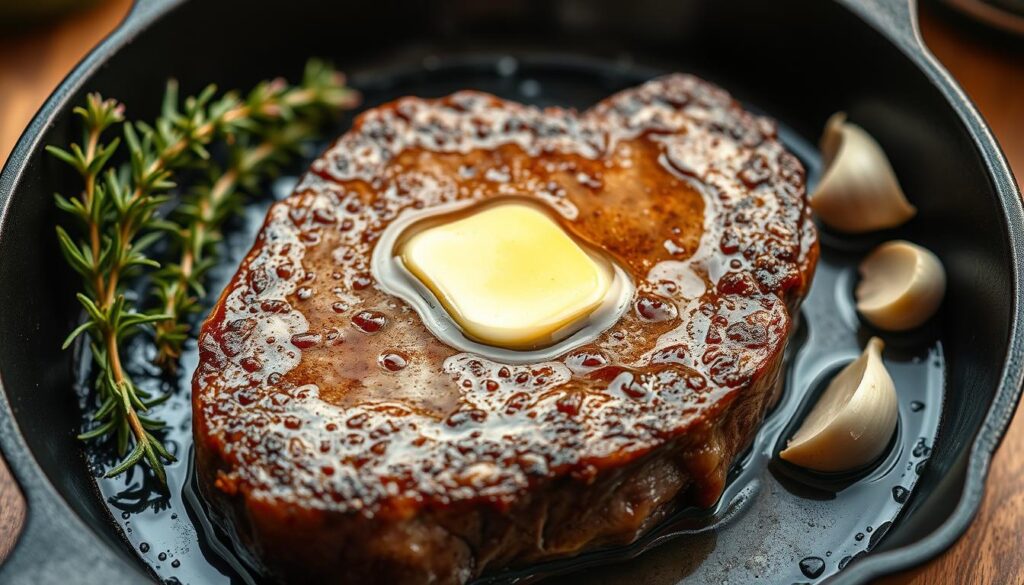
Butter basting steak turns a simple cooking method into a work of art. It involves adding rich, flavorful butter and aromatic ingredients at the end of cooking. This creates a delicious exterior and boosts the meat’s natural flavors.
The secret to great butter basting is timing and technique. Use a heavy-bottomed skillet and high-quality butter. Your steak aromatics should match the meat’s taste.
- Choose unsalted butter for better control of seasoning
- Select fresh herbs like thyme, rosemary, or sage
- Add whole garlic cloves for extra depth
When butter basting your steak, tilt the pan and spoon the melted butter over the meat. This makes a golden-brown crust and adds amazing flavor.
| Aromatics | Flavor Profile | Best Paired With |
|---|---|---|
| Thyme | Earthy, slightly minty | Ribeye |
| Rosemary | Woody, intense | New York Strip |
| Garlic | Pungent, rich | Filet Mignon |
Keep the heat moderate and watch closely to avoid burning. Aim for a rich, nutty butter sauce that complements your steak’s flavors without overpowering it.
Professional Tips for Restaurant-Quality Results
Making a restaurant-quality steak at home is easier than you think. Professional chefs have learned some key tips. These tips can make your home-cooked meals amazing.
The secret to a great steak is knowing a few important techniques. Also, it’s about avoiding common mistakes that can mess up even the best meat.
Common Mistakes to Avoid
- Never cook a cold steak directly from the refrigerator
- Avoid moving the steak too much while cooking
- Don’t cut into the steak immediately after cooking
- Skip using excessive marinades that mask natural meat flavors
Expert Techniques for Exceptional Results
Professional chefs believe in keeping things simple when cooking steak. Less is more when it comes to seasoning. Most top chefs just use salt and black pepper. This lets the steak’s natural flavor stand out.
To improve your steak cooking, follow these important tips:
- Always bring the steak to room temperature before cooking
- Use a cast-iron skillet for perfect searing
- Rest the steak for 5-10 minutes after cooking
- Use a meat thermometer for precise doneness
Creating a restaurant-quality steak is about respecting the meat and knowing the basics. With practice and these techniques, you’ll be cooking like a pro in your kitchen.
Perfect Steak Cutting and Serving Techniques
Learning to cut steak is an art that changes how you enjoy your meals. The way you slice your meat affects its tenderness, taste, and overall enjoyment. Professional chefs say that the right cutting techniques can turn a simple steak into a top-notch dish.
When you serve steak, cutting against the grain is key. This means slicing across the muscle fibers. It makes the steak tender and easier to chew. Your knife should be sharp and clean for smooth cuts.
- Use a sharp chef’s knife for clean cuts
- Identify muscle fiber direction before slicing
- Cut perpendicular to muscle fibers
- Slice against the grain for maximum tenderness
It’s important to let your steak rest before cutting. Let it rest for 5-10 minutes, depending on its thickness. This lets the juices spread evenly, making each slice juicy and flavorful.
| Steak Thickness | Resting Time | Cutting Recommendation |
|---|---|---|
| 1/2 inch | 3-5 minutes | Thin, diagonal slices |
| 1 inch | 5-7 minutes | Medium-width slices |
| 2 inches | 8-10 minutes | Thick, precise cuts |
How you present your steak is important. Serve it on a warm plate to keep it at the right temperature. Slice the steak just before serving to keep it hot and prevent moisture loss. Your guests will love the professional touch and delicious results.
Conclusion
Making the perfect steak at home is an art that needs precision, skill, and love. You’ve learned top-notch techniques to turn simple cuts into amazing dishes. It’s not about being complicated; it’s about knowing the basics and honing your skills.
You’ve learned how to pick the best cuts and control the temperature. This knowledge boosts your confidence in cooking. Whether you love a tender ribeye or a lean NY strip, you can now make steaks that rival those in restaurants. Remember, every great chef began where you are now, eager to learn.
The most important thing in making steak is not in your pantry but in your willingness to try new things. With practice, you’ll get better at techniques like reverse searing and seasoning. Trust your gut, focus on the details, and enjoy the learning journey.
Your cooking journey is just starting. Mastering steak cooking is a lifelong adventure of learning, where every meal is a chance to show off your skills. With these tips, you’re ready to make steaks that will wow your family and friends.


